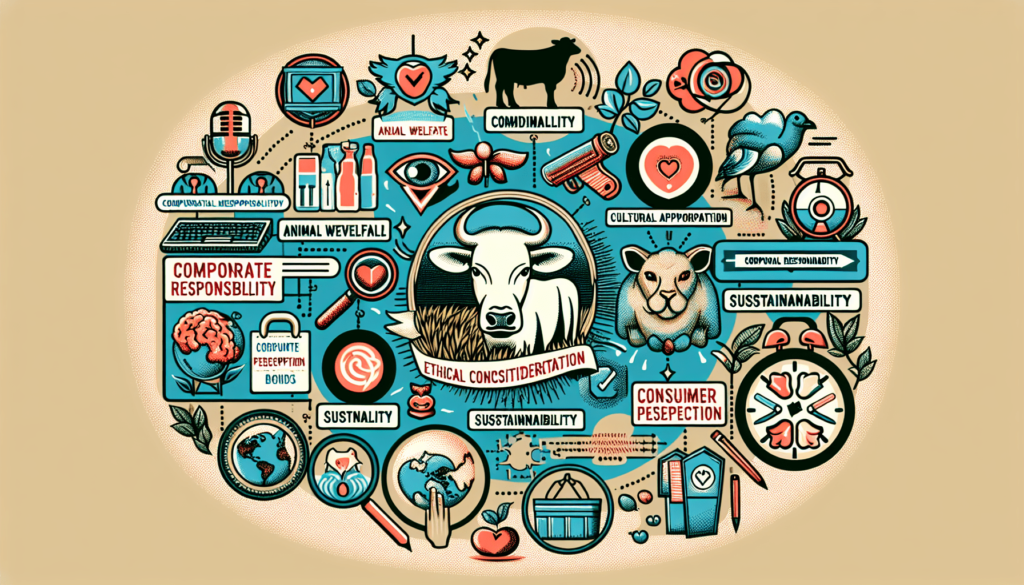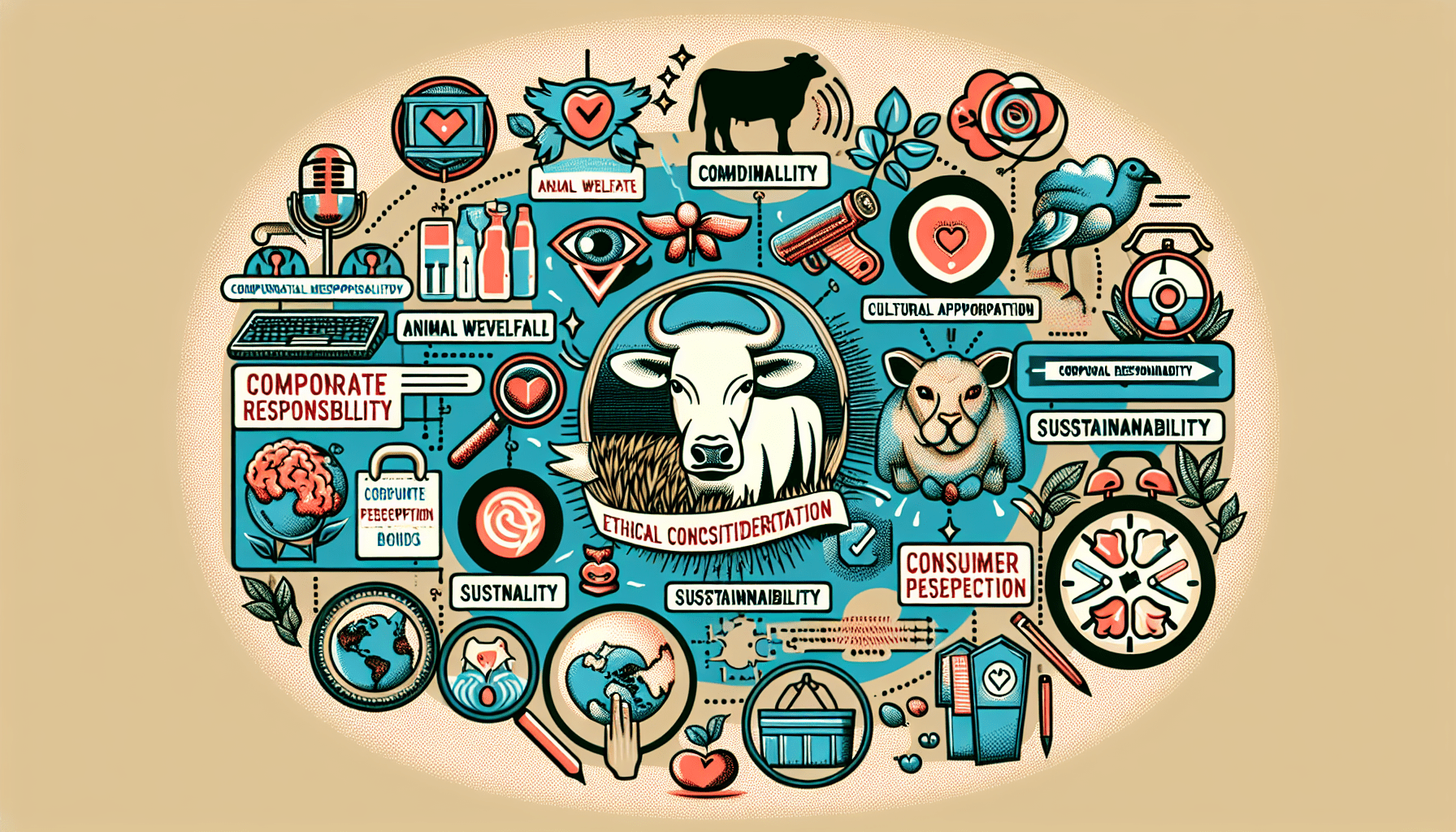Imagine a world where your favorite brands are no longer represented by animals. No more iconic logos of leaping deer, cunning foxes, or majestic lions. In today’s increasingly conscious society, the use of animal imagery in branding has become a topic of ethical debate. From concerns about animal exploitation to the potential reinforcement of harmful stereotypes, this article delves into the complex world of the ethics of using animal imagery in branding. Whether you stand firmly on one side of the argument or find yourself torn in the middle, you’ll discover thought-provoking insights that challenge the status quo and encourage a deeper examination of our relationship with animals in the branding world.
Definition of Animal Imagery in Branding
Using images or representations of animals in branding
Animal imagery in branding refers to the strategic use of images or representations of animals to communicate and enhance the brand message. Brands utilize animal imagery for various reasons, such as symbolizing certain characteristics, appealing to emotions, or creating a connection with consumers. This form of branding is commonly seen in logos, advertisements, packaging, and other visual elements associated with a brand.
Examples of animal imagery in branding
Numerous brands have incorporated animal imagery into their branding successfully. One example is the iconic logo of the sportswear giant, Nike, which features a bold, stylized representation of the Greek goddess of victory, known as Nike. Another well-known example is the Twitter logo, a simple, recognizable blue bird that symbolizes the platform’s ability to spread messages quickly, akin to a bird’s chirping in nature. These examples highlight the power and versatility of animal imagery in shaping brand identities.
The Influence of Animal Imagery in Branding
Impact of animal imagery on consumer perception
Animal imagery in branding has a significant impact on consumer perception. Animals evoke various emotions and associations within individuals, and brands harness these associations to shape consumer opinions. For instance, using a lion as a brand symbol can evoke feelings of strength, leadership, and dominance. On the other hand, a dolphin may evoke feelings of intelligence, friendliness, and harmony with nature. By aligning their brand with specific animals, companies can influence how consumers perceive their products or services.
Emotional connection and psychological effect
Animal imagery in branding creates an emotional connection with consumers and has a profound psychological effect. Humans have an innate fascination and affinity for animals, often finding them endearing or admirable. Incorporating animal imagery into branding can tap into this emotional connection, fostering positive feelings towards a brand. This emotional connection can also play a role in building brand loyalty, as consumers develop a fondness for the brand by associating it with their positive feelings towards the animals depicted.

Animal Welfare Concerns
Exploitation and commodification of animals
One of the main concerns associated with animal imagery in branding is the potential for the exploitation and commodification of animals. Animals used in branding are often reduced to mere symbols, detached from their natural habitats and behaviors. It is crucial to consider the ethical implications of using animals solely for commercial purposes, especially when their well-being is compromised.
Ethical concerns regarding animal captivity for commercial purposes
Some brands use animal imagery that depicts animals found in captivity, such as dolphins in marine parks or elephants used in tourism activities. This raises ethical concerns regarding the welfare of these animals and the morality of profiting from their captivity. Animal rights activists argue that such practices contribute to the suffering of animals and perpetuate harmful industries, prioritizing economic gain over animal wellbeing.
Cultural and Symbolic Significance
Cultural symbolism of animals
Animals hold significant cultural symbolism in various societies around the world. Different animals are associated with specific qualities, values, or beliefs in different cultures. For example, in Western culture, the eagle is often associated with freedom and power, while in some Native American cultures, the bear is revered as a symbol of strength and protection. Brands must be aware of these cultural nuances to ensure they use animal imagery respectfully and accurately.
Appropriation of cultural symbols and misrepresentation
When using animal imagery from specific cultures, there is a risk of appropriating cultural symbols and misrepresenting their meaning. This can lead to cultural insensitivity and offensive stereotypes. It is important for brands to conduct research and engage in respectful dialogue with relevant cultural communities to ensure that they use animal imagery in a way that aligns with cultural values and does not perpetuate harmful stereotypes.

Environmental Impact
Contributions to consumer behavior and sustainability
Animal imagery in branding has the potential to influence consumer behavior towards more sustainable choices. By incorporating images of endangered animals, brands can raise awareness about conservation efforts and inspire consumers to support environmental causes. Additionally, brands that align themselves with sustainable practices or donate a portion of their profits to animal conservation projects can establish a positive reputation and attract environmentally conscious consumers.
Promoting conservation and environmental awareness
Animal imagery in branding can also serve as a powerful tool to promote conservation and environmental awareness. Brands can partner with conservation organizations, create educational campaigns, or use their platform to advocate for animal welfare and environmental protection. By leveraging the influence of their brand, companies have the potential to drive positive change and encourage consumers to adopt more environmentally friendly habits.
Consumer Perception and Relevance
Consumer attitudes towards animal imagery in branding
Consumer attitudes towards animal imagery in branding can vary significantly. Some individuals may feel a strong affinity towards animals and find such imagery appealing, while others may feel indifferent or even skeptical. Factors such as personal values, cultural background, and individual experiences with animals can all shape an individual’s perception of animal imagery in branding. Therefore, brands must consider their target audience and conduct market research to gauge consumer sentiment effectively.
Relevance of animal imagery to product or brand identity
The relevance of animal imagery to a product or brand identity is a crucial consideration. Animal imagery should align with the brand’s values, products, or services. For example, a yoga apparel brand may incorporate imagery of peaceful animals to evoke feelings of tranquility and harmony, aligning with their target audience’s aspirations. It is important for animal imagery to have a meaningful connection to the brand’s story and resonate with its intended message.
Alternatives to Animal Imagery
Exploring non-animal imagery options
For brands seeking to avoid ethical concerns associated with animal imagery, there are numerous non-animal imagery options available. Nature-inspired imagery, geometric shapes, or abstract visuals can convey the desired brand message without relying on animals. By exploring creative alternatives, brands can stay true to their values while still creating a strong visual identity.
Utilizing abstract or conceptual visuals
Abstract or conceptual visuals offer an opportunity for brands to convey their message in a unique and thought-provoking way. These visuals can evoke emotions and spark curiosity while avoiding the potential ethical concerns tied to animal imagery. By utilizing abstract or conceptual visuals, brands can stand out and engage consumers in a more nuanced and artistic manner.
Transparency and Authenticity
Openness about animal imagery usage
Brands that choose to incorporate animal imagery in their branding should strive for transparency. Openly discussing their reasons for using animal imagery and addressing any concerns regarding animal welfare or cultural sensitivity demonstrates a commitment to ethical business practices. By being transparent, brands can foster trust with consumers and show that they are actively engaged in responsible decision-making.
Ensuring authenticity in brand messaging
Authenticity is crucial in brand messaging, especially when using animal imagery. Brands should ensure that their commitment to animal welfare and conservation aligns with their actions beyond visual representations. It is important for brands to follow through on their promises, supporting animal welfare initiatives, and actively contributing to environmental sustainability. By maintaining authenticity in their brand messaging, companies can build lasting relationships with consumers who prioritize ethical practices.
Corporate Social Responsibility
Responsible branding practices
As part of their corporate social responsibility, brands should prioritize responsible branding practices. This involves considering the ethical implications of using animal imagery and making informed decisions that align with the brand’s values and broader societal expectations. By adopting responsible branding practices, brands can mitigate potential ethical concerns and contribute to a more sustainable and compassionate business landscape.
Supporting animal welfare initiatives
To further demonstrate their commitment to ethical practices, brands can actively support animal welfare initiatives. This may involve partnerships with conservation organizations, funding research and initiatives focused on animal welfare, or advocating for legislative changes that protect and promote animal rights. Supporting animal welfare initiatives not only aligns with ethical principles but also enables brands to make a meaningful impact in preserving the natural world.
Ethics in Advertising and Marketing
Balancing ethical considerations in advertising
In advertising and marketing, it is essential to strike a balance between promoting products or services effectively and adhering to ethical considerations. Brands must ensure that their use of animal imagery does not perpetuate harm or reinforce negative stereotypes. By actively considering ethical implications, engaging in dialogue with stakeholders, and regularly reviewing marketing strategies, brands can maintain a conscientious approach to advertising that respects both animals and consumer values.
Respecting consumer values and expectations
Consumers are increasingly placing importance on ethical considerations when making purchasing decisions. Brands must respect and align with consumer values and expectations to maintain a positive brand image and avoid potential backlash. This involves conducting market research, actively listening to consumer feedback, and adapting branding strategies accordingly. By meeting consumer expectations and reflecting their values, brands build trust and foster long-lasting relationships with their target audience.
In conclusion, animal imagery in branding has a significant influence on consumer perception and can create strong emotional connections with consumers. However, ethical concerns regarding animal welfare, cultural appropriation, and environmental impact must be considered. To navigate these concerns, brands can explore alternatives to animal imagery, prioritize transparency and authenticity, embrace corporate social responsibility, and balance ethical considerations in advertising and marketing practices. By adopting a conscientious approach, brands can leverage animal imagery in a way that aligns with their values and resonates with consumers, while fostering a more sustainable and compassionate business landscape.

